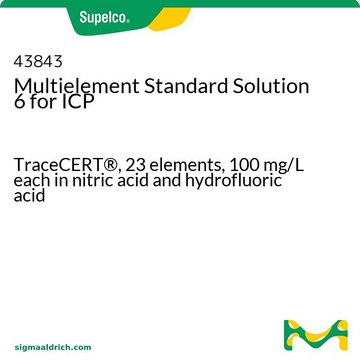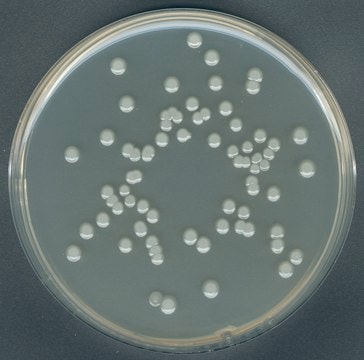1.09493
ICP multi-element standard solution X
for surface water testing (23 elements in dilute nitric acid) Certipur®
Sinónimos:
Multi-Element Calibration Solution for ICP/AAS
About This Item
Productos recomendados
grade
reference material
Quality Level
product line
Certipur®
technique(s)
ICP: suitable
pH
1 (20 °C in H2O)
bp
100 °C/1013 hPa
density
1.007 g/cm3 at 20 °C
application(s)
industrial qc
pharmaceutical
format
multi-component solution
storage temp.
15-25°C
Analysis Note
Mg (Magnesium): 15000 µg/l
Na (sodium): 8000 µg/l
K (potassium): 3000 µg/l
B (boron): 100 µg/l
Fe (iron): 100 µg/l
Mo (Molydenium): 100 µg/l
Sr (Strontium): 100 µg/l
As (arsenic): 50 µg/l
Ba (barium): 50 µg/l
Ni (Nickel): 50 µg/l
V (Vanadium): 50 µg/l
Zn (Zinc): 50 µg/l
Mn (Manganese): 30 µg/l
Co (cobalt): 25 µg/l
Pb (lead): 25 µg/l
Be (beryllium): 20 µg/l
Cd (cadmium): 20 µg/l
Cr (chromium): 20 µg/l
Cu (Copper): 20 µg/l
Bi (bismuth): 10 µg/l
Se (Selenium): 10 µg/l
Tl (Thallium): 10 µg/l
Other Notes
Detailed information on our complete workflow solutions for ICP-AAS can be found in our Brochure: High-Purity Chemicals for Inorganic Trace Analysis.
In our effort to be more sustainable, we′re going digital with COAs-download them directly from our website.
Legal Information
signalword
Danger
hcodes
Hazard Classifications
Eye Dam. 1 - Met. Corr. 1 - Skin Irrit. 2
Storage Class
8B - Non-combustible, corrosive hazardous materials
wgk_germany
WGK 1
flash_point_f
Not applicable
flash_point_c
Not applicable
Certificados de análisis (COA)
Busque Certificados de análisis (COA) introduciendo el número de lote del producto. Los números de lote se encuentran en la etiqueta del producto después de las palabras «Lot» o «Batch»
¿Ya tiene este producto?
Encuentre la documentación para los productos que ha comprado recientemente en la Biblioteca de documentos.
Nuestro equipo de científicos tiene experiencia en todas las áreas de investigación: Ciencias de la vida, Ciencia de los materiales, Síntesis química, Cromatografía, Analítica y muchas otras.
Póngase en contacto con el Servicio técnico








